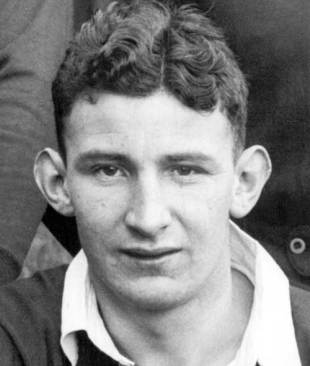
It is given to few - except those, such as royals, who are born to it - to live for more than 70 years after first becoming famous. The point at which Haydn Tanner, who has died aged 92, acquired his enduring rugby fame is not hard to pinpoint.
It was on 28th September 1935 at the St Helen's ground, Swansea. He and his cousin, and fellow Gowerton School pupil, Willie Davies were Swansea's half-backs against New Zealand. The All Whites beat All Blacks 11-3, the first ever win by a club over New Zealand, and to this day their largest margin of defeat by a Welsh team. All Black skipper Jack
Manchester unsuccessfully pleaded to journalists: "Don't tell them back home that we were beaten by schoolboys". Less than two months later Tanner was at it again. Still only 18, he made his Wales debut against the tourists and, partnered by Cliff Jones, played his part in a 13-12 win.
Tanner was one of those rare players who emerged complete - a teenager with the poise and judgment of a veteran. Following his Five Nations debut, the day after his 19th birthday against England at Swansea in January 1936 he was hailed by Dai Gent - writing with the authority of a man who had played the position himself for England - as 'surely Wales's best scrum-half in years'.
Not only in years, but for years. He was a fixed point in the Wales team until 1949, missing only the 1947 match against Australia where his deputy - reflecting an age in which musical tastes often dictated Welsh forenames - was Llanelli's Handel Greville. That 14 year span set a record beaten only in the last few years by Gareth Llewellyn. That he won only 25 caps rather than piling up a record that might also have stood for decades was because so many of those years were lost to the war, in which he was commissioned in the Royal Signals.
He went on tour with the Lions to South Africa in 1938, but for almost the only time in his career was hit by an injury serious enough to deny him all but 10 games and a single test. He also played 12 times for Wales in wartime services and Victory internationals, the lifting of the ban on league players reuniting him on seven occasions with Willie Davies, who had joined Bradford Northern and is remembered as a league rather than union great.
The challenge he set opponents was beautifully summed up in a picture caption in John Morgan and Geoff Nicholson's fine late 1950s work Report on Rugby :"Will he pass the longest, most accurate known passes. Or run the strongest, most deceptive runs known of an inside-half ?". Swansea schoolboys of the era, including my father, were wont to believe that the Tanner Bank at St Helen's was named in honour of their greatest player, at least until it was pointed out that the name predated 1935 and was because it used to cost 6d to stand there.
Whatever Max Boyce may have sung, the truly great Welsh tradition is not outside- but scrum-half. Tanner was the middle link in Welsh scrum-half play's holy trinity - between Dickie Owen, who more or less invented the position and Gareth Edwards, consensus choice as the greatest player ever in any position. Those, like Bleddyn Williams, who played with or against Tanner will tell you that he lost little if anything in comparison with Edwards.
All three came from the Swansea area. Owen played for the All Whites, Edwards for Cardiff. Tanner supplies a link here as well, playing before the war for Swansea but joining Cardiff, a much easier journey from his job teaching at Bristol Grammar School, when he was demobbed.
It might seem odd that he did not score in those 25 peacetime games for Wales - although there was a match-winning try in the victory international at Twickenham. But this was an age when scrum-halves did not score. No scrum-half scored for Wales between Wick Powell against France in 1928 and Onllwyn Brace against Ireland in 1960. Only four tries were scored - the other two by Bobby Delahay against England in 1922 and France in 1925 - by Wales scrum-halves between Owen's last match in 1912 and the arrival of Edwards, who rapidly changed the terms of trade, in 1967. We have it, though, on Bleddyn Williams' authority that Tanner's breaks led to numerous tries for others.
If there is an asterisk against his greatness it is, as with Edwards, captaincy. He led Wales as of right in the first three post-war seasons, but is not remembered as especially imaginative or communicative. Clem Thomas, whose international debut was Tanner's last match, against France in 1949, recalled that his captain barely spoke to him all weekend.
He was, though, a sharp and perceptive observer of the game - credited in 1955 with suggesting to the British Lions selectors that they choose the as-yet uncapped Dickie Jeeps of Northampton, who was to form one of the great Lions half-back partnerships with Cliff Morgan on that year's tour of South Africa.
He was the oldest surviving Welsh international, his death cutting one of the few remaining links with pre-war rugby. As a New Zealand journalist pointed out in the press box at Lord's, where we received the Welsh Rugby Union press release announcing Tanner's death, it leaves the supply of players who have triumphed for Wales over the All Blacks a little closer to depletion. Now there are seven - the survivors of the 1953 team. None of them, not even Bleddyn Williams or Cliff Morgan, was a greater player than Haydn Tanner.

 RSS Feed
RSS Feed